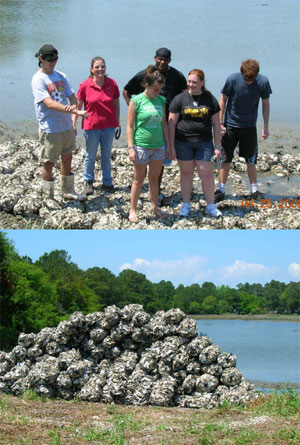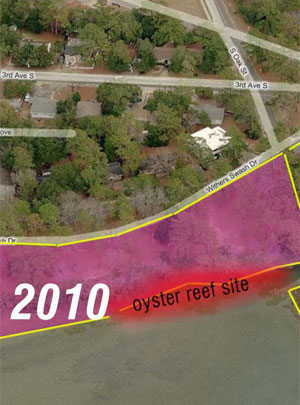Oyster reefs a cheaper and more effective way to clean coastal waters
This post originally appeared ASLA’s “The Dirt” blog as Oyster-Tecture in Action
Sustainable designer Neil Chambers, author of “Urban Green: Architecture for the Future,” made the case for using natural systems to clean and manage water at a conference organized by The Economist. In Myrtle Beach, South Carolina, beach tourism had been negatively impacted by heavy water pollution. Instead of re-engineering the man-made water systems, Chambers decided to use “oyster-tecture.” In one instance of putting innovative ideas into practice, oyster reefs were built to restore the ecological health of the Withers Estuary and its surrounding areas.
Chambers outlined the multi-faceted South Carolina project, which uses an ecosystem-services approach in an innovative and low-cost manner. Formally, the project, which involved federal, state, and local governments, along with local organizations and residents, aimed at improving the water quality of Withers Estuary, Withers Swash, and its connection to the Atlantic Ocean; addressing soil and other contamination throughout the estuary and adjacent areas; and dealing with the severe ecological degradation among the eco-zones of the estuary.
Working with a team of volunteers, he led an effort that involved strategically building oyster reefs at the Withers Swash. All volunteer labor helped keep the total cost of the project to around $3,000. Some 15 reefs were constructed at a cost of $200 each, creating homes for 50,000 oysters. In this form of oyster-tecture, these (unedible) oyster are purifying more than 1.2 million gallons of water each day, restoring the health of the water reaching the beach downstream.

Other components include instituting a water quality monitoring program, establishing guidelines for re-engineering drainage into the watershed, developing ecological approaches for development along the beach, and partnering with the city to preserve the long-term ecological value of the beach.
More broadly, Chambers also calls for a return to nature when dealing with pressing water conservation issues, an approach many landscape architects would also support. For example, he believes Las Vegas is just continuing to use the outmoded approach people have been using for two thousand years: piping water far distances. Chambers explained that water infrastructure is the number one consumer of energy in any city. It takes a lot of energy to pump and convey water through those pipes all the way to homes. As a result, engineered water systems also creates water and air pollution. Instead, natural riverine systems should be allowed to transfer water. “Nature is not straight, but curves.” Calling for restoring habitats and using natural functions to solve our problems, he proposed “un-engineering systems. We need ecological not technological solutions.”
Also worth checking out is a TED talk by Katherine Orff, ASLA, a landscape architect who proposes using oysters to revive New York’s rivers. Her concept was featured in the Museum of Modern Art’s “Rising Currents” exhibition, which explored ideas for using natural systems to protect New York City’s coastline from the sea level rise expected with climate change.
Image credit: Withers Estuary Community Collaborative project / Neil Chambers

